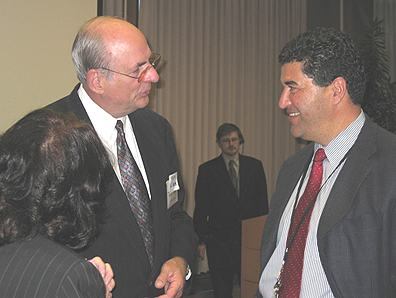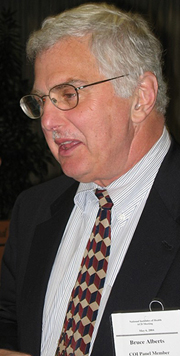
| T H E N I H C A T A L Y S T | M A Y – J U N E 2004 |
|
|
|
NIH
SCIENTISTS AND BLUE-RIBBON
PANEL
|
by Celia Hooper |
 |
|
Intermission:
Panel Co-chair Norman
Augustine (left) and NIH Director Elias Zerhouni during a break in the
action at the ACD meeting May 6 (in the foreground, back to camera, is
Lana Skirboll, associate director for science policy)
|
 |
|
Panel
Co-chair Bruce Alberts
|
Drawing on an outpouring of responses from intramural scientists, the NIH Blue-Ribbon Panel on Conflict of Interest Policies (a working group of the Advisory Committee to the NIH Director, or ACD) has completed a fast-paced, controversial study with "watershed" recommendations on NIH staff’s outside activities. Delivering the panel’s 80-page report and 18 recommendations on May 6, panel co-chair Norman Augustine told the ACD that the 66-day study treads a thin line.
"The panel recognizes NIH as a national treasure, but we realized we could do harm to it. On the one hand, we had to avoid being too liberal and allowing NIH’s credibility to be damaged. On the other hand, we had to avoid being too restrictive so that NIH would not be able to compete for world-class talent and [not] be able to translate research" discoveries into new medical advances, Augustine said.
"We tried to walk that narrow line between these concerns." Augustine is chairman of the Executive Committee of Lockheed Martin Corporation.
In a sparsely attended news conference after the panel’s presentation, NIH Director Elias Zerhouni said the report was a watershed for NIH. "These are profound recommendations."
On May 12, Zerhouni, Augustine, and panel co-chair Bruce Alberts went on to present the report to the House Subcommittee on Oversight and Investigations, where it received a less-than-enthusiastic response. Zerhouni and other NIH leaders were due to make additional visits to Capitol Hill for further testimony on the report’s issues before pursuing changes in policy, rules, and legislation governing what work scientists may pursue on their own time outside of official duties.
In presenting the recommendations on May 6, Alberts commended NIH for its energetic responses to conflict-of-interest concerns, which surfaced last fall and were reported in The Los Angeles Times in December. NIH responses included formation of the NIH Ethics Advisory Committee to review on a centralized basis requests from scientists to perform compensated outside activities.
Alberts also commended the testimony of 30 people appearing before the panel and more than 300 NIH staff members who contributed via a web-site for feedback on outside activities. Alberts, who is president of the National Academy of Sciences, said the panel was impressed by the thoughtful, long responses submitted by NIHers.
He also cited the work of NIH staff members who supported the panel by assembling statistics to put the issues in perspective. Of 17,526 full-time workers at NIH, 118 consult for biotechnology companies, a lower percentage than at most universities, he said.
Augustine said a key overarching observation of the committee was that it would be a "grave error" to ban all outside activities. "We need more controls, but there are very good reasons for participation" by scientists in outside activities, including keeping current with what is happening in academic and industrial research labs—and helping them to keep in touch with progress at NIH. He noted that although the number of scientists who consult with outside groups is small, a ban would disproportionately alienate the most respected scientists and early career investigators who do not want to be denied opportunities in the future.
Another important general point, Augustine said, was to make COI policies sufficiently flexible to serve the public interest in the wide variety of situations that arise. "There are legitimate exceptions to every rule" that could be formulated, Augustine said. "The Director needs to be able to grant exceptions."
Summarizing the recommendations, Augustine said the panel wants to see tightening of restrictions on outside activities for top NIH officials and for staff involved in awarding grants. It also wants to see wider disclosure of outside income from staff members who are currently not required to disclose this information. Disclosure of possible conflicts of interest should accompany any delivery—written or spoken—of research findings.
On the other side of the narrow line it walked, the panel also urged liberalizing restrictions on some outside activities such as teaching, writing, and accepting awards—activities that are "part and parcel of being a member of the scientific community," Augustine said. "To deny this is a mistake."
An example of a restriction that should be lifted, Augustine said, is the one-year, postpublication embargo on scientists’ discussing their NIH research. The panel said publication marked a point when scientists should be able to talk about their work with outside groups.
Members of Zerhouni’s ACD blessed the Blue-Ribbon Panel’s report with a thumbs-up as it set off on a hard journey through Congressional scrutiny and on to rule makers inside and outside NIH.
In the mean time, Zerhouni noted, there has been a sharp decline in new arrangements for outside activities at NIH. "Scientists do not want to deal with the hassle until this is settled," he speculated. The report itself noted, "many scientists sense that they are unfairly being forced to live under a cloud of suspicion."
The report called for
the quickest possible action on its recommendations: "This is needed to
assure the continued, deserved public confidence in the extraordinary work of
NIH, to continue to enhance the quality
of the scientific staff at NIH, and to rectify what the Panel perceives as a
critical and growing morale problem among the agency’s excellent staff."
![]()
The final report can be seen here.